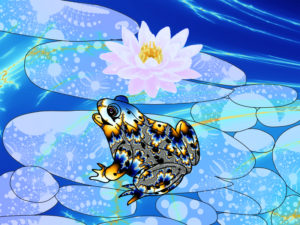Scientific Advances and New Discoveries
 A study published out of Hiroshima University in 2021 supports frogs as the ancestor of other vertebrates, stating “What’s more, the research team uncovered that the potential sex-chromosomes involved in the translocations contained orthologs of the sex-determining genes in mammals, birds, and fishes.”
A study published out of Hiroshima University in 2021 supports frogs as the ancestor of other vertebrates, stating “What’s more, the research team uncovered that the potential sex-chromosomes involved in the translocations contained orthologs of the sex-determining genes in mammals, birds, and fishes.”
A 2021 TED talk by Michael Levin reviews new research with frogs that is helping to identify and manipulate an electrical communication between cells (not related to the nervous systems) that tells cells how to behave.
From The Urantia Book
(59:6.8) Among the land animals the frogs reached their climax in the preceding age and rapidly declined, but they survived because they could long live even in the drying-up pools and ponds of these far-distant and extremely trying times. During this declining frog age, in Africa, the first step in the evolution of the frog into the reptile occurred. And since the land masses were still connected, this prereptilian creature, an air breather, spread over all the world. By this time the atmosphere had been so changed that it served admirably to support animal respiration. It was soon after the arrival of these prereptilian frogs that North America was temporarily isolated, cut off from Europe, Asia, and South America.
(61:2.6) Along with the disappearance of the dinosaurs, other and great changes occurred in the various branches of the saurian family. The surviving members of the early reptilian families are turtles, snakes, and crocodiles, together with the venerable frog, the only remaining group representative of man’s earlier ancestors.
(62:3.9) You can hardly realize by what narrow margins your prehuman ancestors missed extinction from time to time. Had the ancestral frog of all humanity jumped two inches less on a certain occasion, the whole course of evolution would have been markedly changed. The immediate lemurlike mother of the dawn-mammal species escaped death no less than five times by mere hairbreadth margins before she gave birth to the father of the new and higher mammalian order. But the closest call of all was when lightning struck the tree in which the prospective mother of the Primates twins was sleeping. Both of these mid-mammal parents were severely shocked and badly burned; three of their seven children were killed by this bolt from the skies. These evolving animals were almost superstitious. This couple whose treetop home had been struck were really the leaders of the more progressive group of the mid-mammal species; and following their example, more than half the tribe, embracing the more intelligent families, moved about two miles away from this locality and began the construction of new treetop abodes and new ground shelters—their transient retreats in time of sudden danger.
(65:2.6) The stage was thus set for the appearance of the first backboned animals, the fishes. From this fish family there sprang two unique modifications, the frog and the salamander. And it was the frog which began that series of progressive differentiations in animal life that finally culminated in man himself.
(65:2.7) The frog is one of the earliest of surviving human-race ancestors, but it also failed to progress, persisting today much as in those remote times. The frog is the only species ancestor of the early dawn races now living on the face of the earth. The human race has no surviving ancestry between the frog and the Eskimo.
(65:2.8) The frogs gave rise to the Reptilia, a great animal family which is virtually extinct, but which, before passing out of existence, gave origin to the whole bird family and the numerous orders of mammals.
(65:2.9) Probably the greatest single leap of all prehuman evolution was executed when the reptile became a bird. The bird types of today—eagles, ducks, pigeons, and ostriches—all descended from the enormous reptiles of long, long ago.
(65:2.10) The kingdom of reptiles, descended from the frog family, is today represented by four surviving divisions: two nonprogressive, snakes and lizards, together with their cousins, alligators and turtles; one partially progressive, the bird family, and the fourth, the ancestors of mammals and the direct line of descent of the human species. But though long departed, the massiveness of the passing Reptilia found echo in the elephant and mastodon, while their peculiar forms were perpetuated in the leaping kangaroos.
(65:3.3) You have been informed that Urantia mortals evolved by way of primitive frog development, and that this ascending strain, carried in potential in a single frog, narrowly escaped extinction on a certain occasion. But it should not be inferred that the evolution of mankind would have been terminated by an accident at this juncture. At that very moment we were observing and fostering no less than one thousand different and remotely situated mutating strains of life which could have been directed into various different patterns of prehuman development. This particular ancestral frog represented our third selection, the two prior life strains having perished in spite of all our efforts toward their conservation.
(100:1.4) Children are permanently impressed only by the loyalties of their adult associates; precept or even example is not lastingly influential. Loyal persons are growing persons, and growth is an impressive and inspiring reality. Live loyally today—grow—and tomorrow will attend to itself. The quickest way for a tadpole to become a frog is to live loyally each moment as a tadpole.